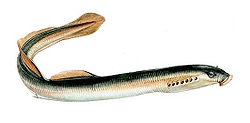| Lombardy lamprey | |
|---|---|
 | |
| Scientific classification | |
| Kingdom: | Animalia |
| Phylum: | Chordata |
| Infraphylum: | Agnatha |
| Superclass: | Cyclostomi |
| Class: | Petromyzontida |
| Order: | Petromyzontiformes |
| Family: | Petromyzontidae |
| Genus: | Lampetra |
| Species: | L. zanandreai |
| Binomial name | |
| Lampetra zanandreai (Vladykov, 1955) | |
| Synonyms [2] | |
| |
Lampetra zanandreai, the Lombardy lamprey, is a species of lamprey in the Petromyzontidae family. It is found in Croatia, Italy, and Slovenia. Its natural habitats are rivers and freshwater springs. It is threatened by habitat loss.



